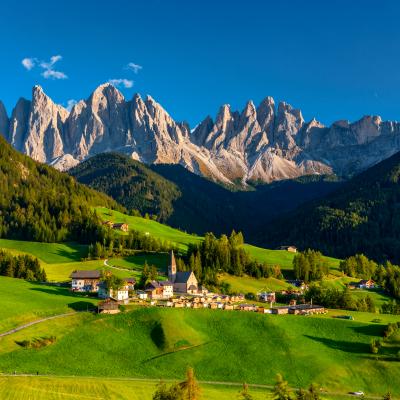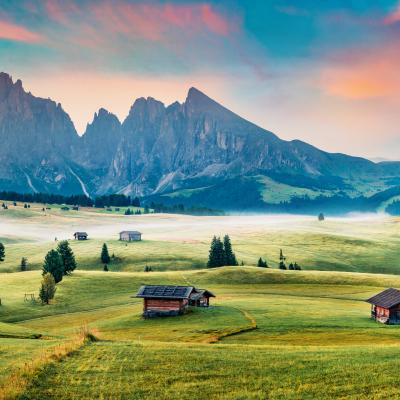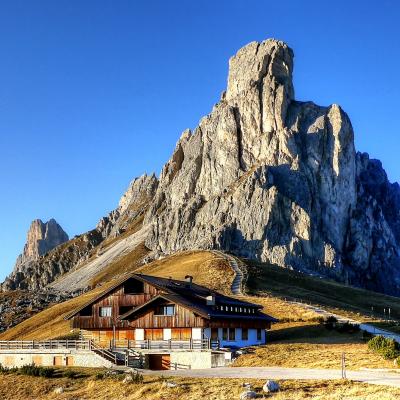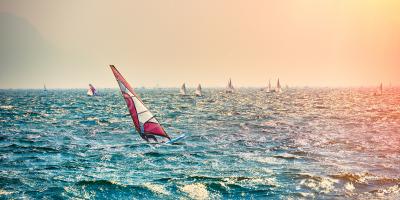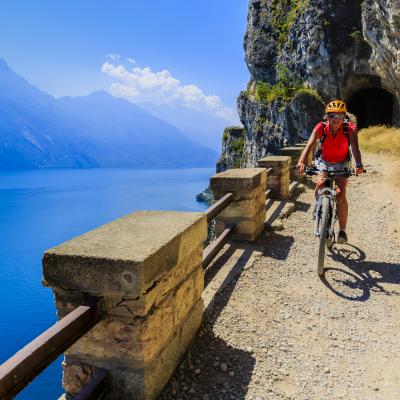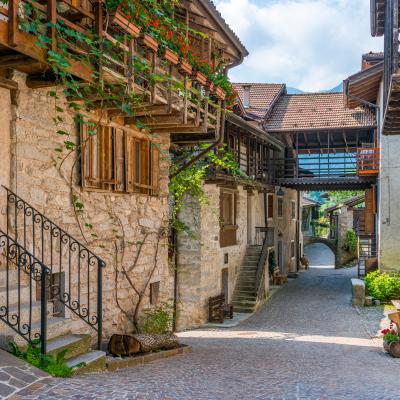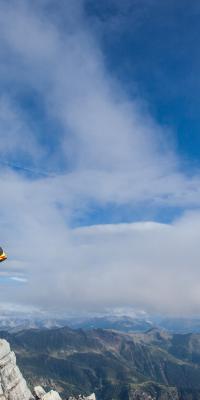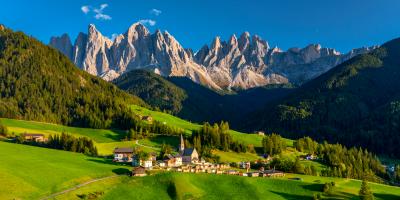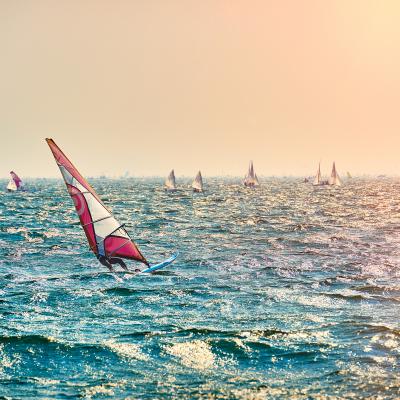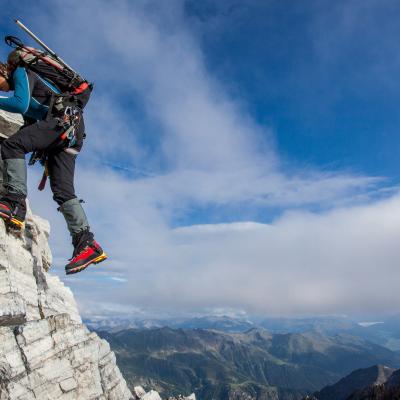Trentino-Alto Adige
The northernmost region of Italy, it has constituted since 1948 an autonomous region with special status consisting of two regions. Alto-Adige to the north, which corresponds to the autonomous province of Bolzano essentially of German language and culture, derives its name from the Adige River, whose upper section of the river basin it occupies; Trentino to the south, which corresponds to the autonomous province of Trento of Italian language and culture, derives its name from that of the capital. Characterized by a marvelous landscape, Trentino Alto-Adige boasts a still virgin and unspoiled nature, where splendid valleys, lakes, streams and, of course, the imposing peaks that dominate the entire region and are home to numerous resorts, both winter and summer, such as Madonna di Campiglio, San Martino di Castrozza, Corvara, Canazei, Alpe di Siusi, Val Gardena, Val Badia and many others that enjoy great fame and notoriety.
Alta Badia encompasses six villages (Corvara, Colfosco, La Val, La Villa, Pedraces, San Cassiano) framed by the imposing Dolomite peaks. A ski paradise and an ideal destination for hikers, rich in tradition and important events, Alta Badia has for years been one of the most famous and fascinating areas in the Dolomites. In winter, in addition to offering one of the largest ski areas in the Alps, it is the starting point for the famous Sella Ronda tour, known as the Giro dei Quattro Passi. In summer, there are many walks of varying difficulty on the magnificent surrounding peaks. It is also distinguished by the presence of several restaurants led by some of the best chefs in Italy.
Andalo is a municipality of just over a thousand inhabitants in the province of Trento, ideal for those who love skiing and fun, forming part with Fai della Paganella of the Fai della Paganella ski area. Located in a wide basin between the Brenta Dolomites and the skiable slopes of Paganella, it has numerous hotel facilities to meet every need and infrastructure for different types of sports. A feature appreciated by skiers is the presence close to the center of as many as 2 ski lift departures, and the arrival of ski slopes all the way to the village.
Bolzano
Bolzano is defined as the Capital of the Alps. Indeed, it is home to the Archaeological Museum with Ötzi, the Iceman, and R.Messner's International Mountain Museum. Three language groups coexist in Bolzano: Italian, German and Ladin. There are numerous castles in the municipal area(the Bolzano basin has been declared the area with the highest density of castles in Europe). Worth visiting in the historic center is Castel Mareccio.
Merano
Merano is a South Tyrolean town in the province of Bolzano surrounded by mountains. It is located at the beginning of four important valleys: the Vinschgau, Passeiertal, Etsch and Ulten valleys. Merano enjoys a long tradition as a spa town and tourist center. The old town offers numerous artistic attractions, while a wide variety of activities can be found in the surrounding area: music, sports, hiking, wine tourism, spas, and congresses.
Val Gardena
The Gardena Valley stretches about 25 km in the northwestern part of the South Tyrolean Dolomites. The valley rises from Ponte Gardena (471 m) to the Sella Group, with the Sella and Gardena Passes marking the border with other Ladin valleys. Along the valley are the municipalities of Selva Gardena, Ortisei, and Santa Cristina. In addition to being an ideal place for all winter sports and long hikes among the most fascinating peaks of the Dolomites, Val Gardena is famous for artistic handicrafts with wood. Wood carving, which now has a centuries-old tradition, still represents one of the most important branches of modern industry in Val Gardena, while retaining its nature as a purely artisan activity that produces original, refined and imaginative works.
Trento
Trento arose in Roman times overlooked by Doss Trento on the right bank of the Adige River where the Mausoleum dedicated to Cesae Battisti stands today. The historic center was moved to the opposite bank of the river and a very high city wall was built around it. Around the year 1,000, Conrad II, wanted to create a bishopric in Trent, and this made the city a focal point for religious people. It became so important that Trent was the place where the Council of Trent and its reforms were held.
Today its economy is mainly based on the industrial sector where a very important agricultural activity is also observed. Also relevant is the tourism sector, especially the cultural and excursion sector; woodworking, wrought iron, aimed especially at making furniture and furnishings, are still widespread.
The temperature in Trento suffers from the Foehn phenomenon with hot summers exceeding 30°C up to 35°C especially in the Bolzano basin, which often turns out to be the hottest Italian city in summer. Winter is harsh in the highest areas, the temperature can drop to -30°C. Lake Garda, however, mitigates temperatures making them milder.Trento offers many opportunities for recreation, culture and sports. Things to see include the Basilica of San Vigilio, the historic Buonconsiglio Castle, the Mart in Rovereto near Trento, the Praetorian Palace and Civic Tower, and the Roccabruna Palace.
Madonna di Campiglio
Madonna di Campiglio is located in the heart of Val Rendena, in western Trentino. To the east, the valley is bounded by the Brenta Dolomites, while on the other side, separating it from Lombardy, rise the Adamello and Presanella Groups. These two imposing mountain groups give the valley a spectacular setting. Mountains that, despite their grandeur and extension, are far from inaccessible: in fact, there is a dense and widespread network of trails that allow you to reach the numerous mountain huts located at even very high altitudes. Madonna di Campiglio stands out, however, as one of the most famous ski areas in the Alps. The variety of the natural environment ensures that in winter, starting from the town center and returning to it without ever taking off the skis, 60 kilometers of slopes that are always different in degree of difficulty.
San Martino di Castrozza
San Martino di Castrozza is a well-known tourist resort in the province of Trento, surrounded by the Paneveggio - Pale di San Martino Nature Park and located in the upper Primiero Valley. High and wild, the Pale Mountains are the unmistakable icon of this beautiful mountain town: mighty towers of rock that attracted pioneers of Dolomite apinism since the 1800s. Once the pastureland of Fiera di Primiero, today San Martino di Castrozza is the valley's most important center, as well as an elegant and bustling Alpine capital, forming the southernmost point of the Dolomiti Superski carousel, the largest existing ski consortium in Europe. The charm of the landscape is enhanced and protected by the presence of the Nature Park, along whose trails snowshoeing and several cross-country trails are available. For downhill skiing, the entire valley refers to San Martino and its 60 kilometers of slopes. Don't miss Passo Rolle, which connects San Martino di Castrozza with Predazzo, in the Fiemme Valley.
